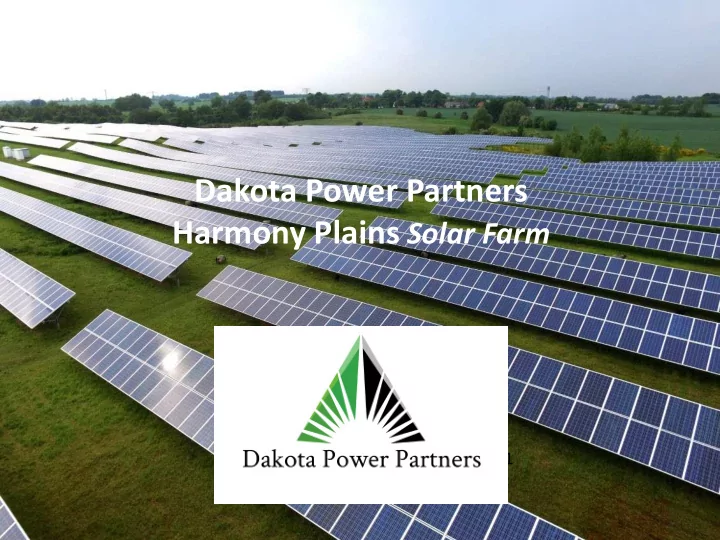

Dakota Power Partners Harmony Plains Solar Farm 1
About Us Dakota Power Partners Led by energy industry veterans, Dakota Power Partners works closely with local communities, landowners, and utilities to develop large-scale clean energy projects. Our projects produce low-cost clean energy, benefit host communities, and create 21st century American jobs. The principals of Dakota Power Partners have more than 60 years of combined experience in the US power generation industry and have collectively developed more than 1,000 MW of operating and in-construction wind and solar projects around the US, representing an aggregate capital investment in rural communities in excess of $1.4 billion. Dakota Power Partners currently is the only developer of utility-scale solar projects in New Jersey with approximately a dozen projects under development that will represents approximately $1 billion in planned investment. MAP Energy Dakota Power Partners’ primary investor is MAP Energy. MAP Energy, based in Palo Alto, CA, is one of the oldest and most successful private energy investors in the US with ~$2.5 billion in committed capital and ongoing annual investments of ~$150 million. MAP Energy has invested ~$600 million in early and mid-stage wind and solar development projects resulted in 12,700 MW of operating renewable energy projects by the end of 2019. 2 CONFIDENTIAL
Facility Location 3
Harmony Plains Solar Farm - Overview Land : 593-acre project area Solar Capacity : 70 MWac Interconnection : 115 kV JCP&L High- Voltage line adjacent to site Site Access : Garrison Rd, Brainards Rd and Harmony Station Rd. Design Life : 30 years Investment: $90 million Planned Commercial Operations Date : 2022/2023 4
New Jersey’s Energy Plan • New Jersey released its 2019 Energy Master Plan in January 2020. • Renewable energy supply targets: – 50% by 2030 – 100% by 2050 • 34% of the energy is to come from solar generation located in New Jersey. Today, just 5% of the energy in New Jersey comes from solar. • To achieve this goal would require the state to develop approximately 6,000 acres of new solar generation each and every year. 5
General Considerations • No noise, air emissions or water pollution • No additional vehicles on local roads (except during construction) • Renewable power equivalent to 11,000 homes (25% of Warren County homes) • No impact to surrounding property values • No water use or discharge • No impact to town and county services Inherently Beneficial Use: “a use which is universally considered of value to the community because it fundamentally serves the public good and promotes the general welfare. Such uses include, but are not limited to, a hospital, school, child care center, group home, or a wind, solar or photovoltaic energy facility or structure.” 6 NJ Municipal Land Use Law (N.J.S.A. 40:55D-4)
Site Selection – Why Here? • The Harmony Plains Solar project site is ideally suited for utility-scale solar • Access to High-Voltage Lines: 115 kV and 230 kV lines adjacent to the site • Transmission Congestion: Sheltered for impacts from proposed offshore-wind farms along NJ coastline • Ideal site conditions: Flat, well-drained soils at a scale that allows for a economically-viable solar project 7
Economic Benefits Tax & Lease Revenue • Under the lease agreement with the Town of Harmony, the solar farm will pay $10MM over its lifetime. • Additionally, the solar farm will pay over $4.5MM in property tax over its lifetime. Employment • 200-300 construction jobs • 4-6 FTE operations and maintenance jobs Investment in the Community Local Construction Year Spend: (Restaurants, Gas, Hotels, Local Materials Purchases, Equipment Rentals, Local Construction Contractor Spend) $5,000,000 Local Construction Wages $7,500,000 Estimated Local Tax Revenue & Town Lease Payments Over 30 Year Project Life $14,500,000 Operations & Maintenance Wagers Over 30 Year Project Life $3,750,000 Aggregate Direct Economic Benefit Over 30 Year Project Life $30,750,000 8
Fiscal Analysis 9
Where Does Electricity Go? Panel to grid to Substation Existing Transmission Lines end user • Electricity goes on transmission lines • Sold to home, offices and factories 10
Property Info 11
Facility Component Overview Panels and Racking Substation Roads Inverter 12
Solar Panels Size: ~3ft x 6 ft 13
Racking System 14
Safety • Safety is #1 priority • Fence around the perimeter for safety and security – Signage will be posted where needed – First responders will have access to the site • Electrical equipment will generally be enclosed meeting electrical standards UL, IEEE, etc. • Substation will be set back from the road, minimize visibility and access • Panels are low voltage ~35v • Safety program implemented prior to construction – First responder – Training for all employees – Tag out procedures – Anyone on site will be safety trained 15
Project Decommissioning • Typical Project Design Life – 30 years • Project Decommissioning – Removal of all equipment – Panels, cable, racking system – Minimal foundations – Considerable scrap value for steel, copper, aluminum • Decommissioning Bond • Fields have remained fallow for 30 years – Nutrients regained 16
Recommend
More recommend